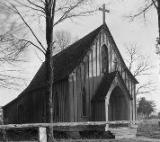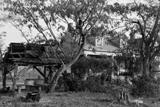
Historic American Buildings Survey Alex Bush, Photographer,
January 10, 1935 FRONT AND SIDE VIEW N.E. HABS, ALA,
32-FORK,1-1 |
St. John's-In-The-Prairie
SR 4, Forkland
Historic Marker Text:
Organized "in the Prairie" south of Greensboro in 1834 by the Rev. Caleb Ives,
pioneer missionary to the old Southwest. Admitted to parish status in 1838 by
the Rt. Rev. Jackson Kemper, Provisional Bishop of Alabama. First rector was the
Rev. John Avery, D. D. Present building designed by Mr. Richard Upjohn, renowned
American architect and founder of the American Institute of Architects. Erected
in 1859 and moved across the Warrior River to its present location in 1878.
Data Card
Photograph of the
rear of the church, courtesy of the Department of Art of The University of
Alabama.
Photograph of the
cemetery, courtesy of the Department of Art of The University of Alabama.
National
Register of Historic Places |
 |
Strawberry Hill Plantation
(1821): William Walton
was a native of Georgia and an officer on the staff of General George
Washington. His older brother, George, signed the Declaration of
Independence. As a Revolutionary War Officer he received a land
grant of several thousand acres and in 1821 built the Strawberry
Hill Plantation home about thirteen miles South of present day Eutaw.
Photo of Slave
House |